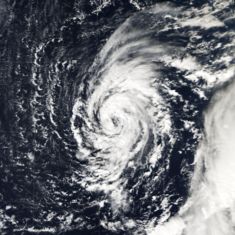Tropical Storm Delta (2005)
2007 Schools Wikipedia Selection. Related subjects: Storms
| Tropical storm ( SSHS) | ||
|---|---|---|
|
Tropical Storm Delta near peak intensity |
||
| Formed | November 22, 2005 | |
| Dissipated | November 29, 2005 | |
| Highest winds |
|
|
| Lowest pressure | 980 mbar hPa | |
| Damage | $364+ million (2005 USD) | |
| Fatalities | 7-19 direct | |
| Areas affected |
Canary Islands, Morocco, Algeria | |
| Part of the 2005 Atlantic hurricane season |
||
Tropical Storm Delta was a late-forming tropical storm of the 2005 Atlantic hurricane season which struck the Canary Islands as a strong extratropical storm causing significant damage and then crossed over Morocco with little impact there. It was the twenty-sixth tropical or subtropical storm of the season.
Tropical Storm Delta, like most late-season storms, developed out of an extratropical low. The storm only gradually gained tropical characteristics and was briefly a subtropical storm on November 22. Delta moved erratically for a few days before moving towards the Canary Islands. It became extratropical just before it passed to the north of the archipelago.
Storm history
On November 22, a non-tropical area of low pressure in the central Atlantic Ocean began to gain some tropical characteristics. Late that afternoon the low became Subtropical Storm Delta, while located over 800 miles (1300 km) west-southwest of the Azores. Operationally the National Hurricane Centre considered that the storm had already gained enough tropical characteristics to be classified as a tropical storm, but in post-storm analysis this was reconsidered.
The storm's convection became more organized and Delta became a tropical storm on November 24. It strengthened further to its peak strength of 70 mph (110 km/h) later that day, just below hurricane strength. The official forecast at this time predicted that Delta would strengthen further and become a minimal hurricane, but this did not occur. Delta maintained this strength for a few days as it moved slowly and erratically in the central Atlantic. As shear increased over the storm, a weakening trend began on November 25 and by the end of the next day Delta had weakened into a minimal tropical storm. Some of the computer models showed that the weakening tropical storm could be absorbed by a developing low to the west, which a few days later became Hurricane Epsilon. This did not occur, and Tropical Storm Delta began to move to the northeast.
As Delta accelerated to the northeast towards the Canary Islands, it intensified again, reaching a second peak of just under hurricane strength on November 27. In post-storm analysis, the NHC noted that there was a possibility that Delta had briefly reached hurricane strength that day; however, the data was not conclusive enough to justify an upgrade to hurricane status. On November 28, as it neared the Canary Islands Tropical Storm Delta lost its tropical characteristics. The extratropical storm, which maintained winds of near-hurricane strength, passed about 105 miles (165 km) north of the islands that night. The storm moved over Morocco early on November 29 and rapidly weakened overland, dissipating late that day over northwestern Algeria.
Impact
Considerable damage was reported in the Canary Islands as a result of Delta, where it was described as a "historic" event, as hurricanes are extremely rare there. The islands of Tenerife and La Palma were hardest hit, with many uprooted trees and landslides reported there. The peak gust recorded at La Palma was 152 km/h (95 mph), and at Tenerife the maximum gust was 147 km/h (90 mph). One hospital had to be evacuated and several airports were closed across the islands. In all, over 225,000 customers lost electricity and many lost telephone service.
In addition, a famous natural tourist attraction, El Dedo de Dios (or God's finger), a geological feature which had been pointing towards the sky for over a millennium and an important landmark for the Canary Islands, was destroyed by Delta's winds and wave action along Gran Canaria's shore. Delta claimed seven lives; six of them were immigrants that were on a boat that sank off the Canary Islands and 12 were reported missing. The seventh was a result of winds throwing a man off a house while it was being repaired during the storm.
The total damage caused by Tropical Storm Delta throughout the Canaries was estimated to be over €312 million ($364 million 2005 US dollars). Delta was also blamed for a 10-15% reduction of the islands tuna catch, as it kept the fishermen in port for several days.
Delta was described as a "normal atmospheric disturbance" in Morocco and no damage was reported there. In fact, it was welcomed as farmers needed the rain there to complete the sowing of cereal crops.
Records
When Subtropical Storm Delta formed on November 22, it was the first time that twenty-six tropical or subtropical storms had formed in the Atlantic during one hurricane season.



